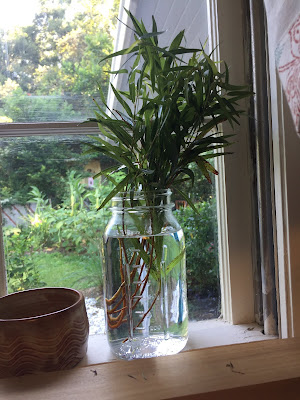 |
| Prepping Salix caroliniana cuttings for rooting in a mason jar |
Purchasing plants from the home improvement store or from your local nurseries can be expensive with quart size or one gallon specimens starting at six to eight dollars apiece and going up from there. Ten plants can easily run one hundred dollars including sales tax.
There are other alternatives however. One such alternative is taking cuttings from mature plants and rooting them in your kitchen window. Rooting plant cuttings is much easier than most people consider, and doesn't take a whole lot of time. Over the years, Judy and I have rooted hundreds of thousands of cuttings to use in the permaculture garden, sell or give away to friends and family. There are so many plants already established in yards and across forests and farms. Always make sure you have the permission of the property owner when taking a plant cutting.
 |
| Salix caroliniana branches ready for cutting and rooting |
Roses, rosemary, marjoram, basils, figs and even native hollies (Ilex spp.) can be rooted in a mason jar half filled with water then placed in an area protected from the desiccating wind that provides partial shade and exposure to partial sunlight. Friends and family always love the gift of a freshly potted garden plant. Having a nice supply of rooted cuttings out back is also a great way to send unexpected company on their way when the visit is over.
 |
| I always carry freezer bags to store cuttings until I get home. A wet paper towel included keeps the cuttings damp. |
The other day we were out and about and came across a Coastal Plains Willow, Salix caroliniana, a native tree found growing through Florida. Willow is an important plant for every yard for many reasons. Willow serves as foraging and communal habitat for wildlife and birds, sequesters carbon, mitigates urban heat island effect, creates fresh oxygen for the air, is a traditional medicinal plant and besides being beautiful, the inner bark serves as an excellent rooting compound for those harder to root hardwood cuttings.
Willows enjoy damp soils and will grow in areas of your plot where other plants wont thrive.
 |
| Coastal Plain Willow cuttings in the window ready to root |
I cut three or four twelve inch stems from the back side of the willow and placed in one of the gallon size zipper freezer bags I normally carry for obtaining opportune cuttings, also splashing a handful of water into the plastic cuttings bag.
Back at our urban farm permaculture place I half filled a mason jar with collected rainwater and placed the cuttings in the jar. We've built a small shelf in the kitchen window to hold these rooting jars. I like the plants in the house too. In fact I could probably live in a living house made from plants.
Within a couple weeks small new roots began appearing from the semi-hardwood cuttings and within a month (be sure to refill the mason jar as the water evaporates) the cuttings each had a mass of roots and were ready to transplant up into 4" pots.
Once transplanted into the pots we give the rooted cuttings a couple of weeks for good root establishment, watering daily, before giving away as gifts or planting in the garden.
 |
| Salix caroliniana, Coastal Plain Willow rooted cuttings in their destination pots |
There is no secret to rooting plant cuttings. The incision I make when cutting a branch from the mother plant is angled and I like to find the sweet spot between hardwood and softwood on the branch. This sweet spot varies between plants but is generally six to 12 inches from the branch tip. Cuttings will root at just about any length though with the right mojo blessings.
Why buy plants? Supporting your local nurseries is a good thing. But if you are a poor botanical artist like me then cuttings are botanical candy!
No comments:
Post a Comment